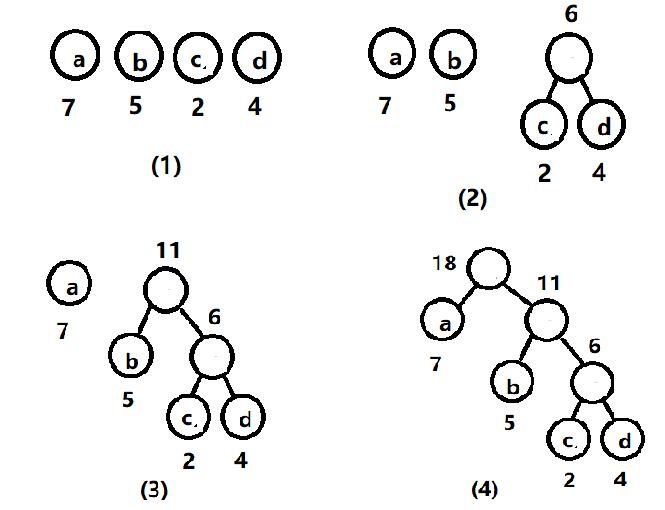踩過無數坑實現的哈夫曼壓縮(JAVA)
最近可能又是閒著沒事幹了,就想做點東西,想著還沒用JAVA弄過資料結構,之前搞過演算法,就試著寫寫哈夫曼壓縮了。
本以為半天就能寫出來,結果,踩了無數坑,花了整整兩天時間!!orz。。。不過這次踩坑,算是又瞭解了不少東西,更覺得在開發中學習是最快的了。
話不多說,進入正題
首先先來講講哈夫曼樹
哈夫曼樹屬於二叉樹,即樹的結點最多擁有2個孩子結點。若該二叉樹帶權路徑長度達到最小,稱這樣的二叉樹為最優二叉樹,也稱為哈夫曼樹(Huffman Tree)。哈夫曼樹是帶權路徑長度最短的樹,權值較大的結點離根較近。

哈夫曼樹的構造
假設有n個權值,則構造出的哈夫曼樹有n個葉子結點。 n個權值分別設為 w1、w2、…、wn,則哈夫曼樹的構造規則為:
(1) 將w1、w2、…,wn看成是有n 棵樹的森林(每棵樹僅有一個結點);
(2) 在森林中選出兩個根結點的權值最小的樹合併,作為一棵新樹的左、右子樹,且新樹的根結點權值為其左、右子樹根結點權值之和;
(3)從森林中刪除選取的兩棵樹,並將新樹加入森林;
(4)重複(2)、(3)步,直到森林中只剩一棵樹為止,該樹即為所求得的哈夫曼樹。

哈夫曼編碼
在資料通訊中,需要將傳送的文字轉換成二進位制的字串,用0,1碼的不同排列來表示字元。例如,需傳送的報文為“HELLO WORLD”,這裡用到的字符集為“D,E,H,L,O,R,W”,各字母出現的次數為{1,1,1,3,2,1,1}。現要求為這些字母設計編碼。要區別7個字母,最簡單的二進位制編碼方式是等長編碼,固定採用3位二進位制,可分別用000、001、010、011、100、101、110對“D,E,H,L,O,R,W”進行編碼傳送,當對方接收報文時再按照三位一分進行譯碼。顯然編碼的長度取決報文中不同字元的個數。若報文中可能出現26個不同字元,則固定編碼長度為5。然而,傳送報文時總是希望總長度儘可能短。在實際應用中,各個字元的出現頻度或使用次數是不相同的,如A、B、C的使用頻率遠遠高於X、Y、Z,自然會想到設計編碼時,讓使用頻率高的用短編碼,使用頻率低的用長編碼

此時D->0000 E->0001 W->001 H->110 R->111 L->01 0->02
固定三位時編碼長度為30,而時候哈夫曼編碼後,編碼長度為27,很明顯長度縮小了,得到優化。
下面就是程式碼實現
HuffmanCompress.java
package 哈夫曼; import java.io.DataInputStream; import java.io.DataOutputStream; import java.io.File; import java.io.FileInputStream; import java.io.FileNotFoundException; import java.io.FileOutputStream; import java.util.Arrays; import java.util.HashMap; import java.util.PriorityQueue;public class HuffmanCompress { private PriorityQueue<HufTree> queue = null; public void compress(File inputFile, File outputFile) { Compare cmp = new Compare(); queue = new PriorityQueue<HufTree>(12, cmp); // 對映位元組及其對應的哈夫曼編碼 HashMap<Byte, String> map = new HashMap<Byte, String>(); int i, char_kinds = 0; int char_tmp, file_len = 0; FileInputStream fis = null; FileOutputStream fos = null; DataOutputStream oos = null; HufTree root = new HufTree(); String code_buf = null; // 臨時儲存字元頻度的陣列 TmpNode[] tmp_nodes = new TmpNode[256]; for (i = 0; i < 256; i++) { tmp_nodes[i] = new TmpNode(); tmp_nodes[i].weight = 0; tmp_nodes[i].Byte = (byte) i; } try { fis = new FileInputStream(inputFile); fos = new FileOutputStream(outputFile); oos = new DataOutputStream(fos); /* * 統計字元頻度,計算檔案長度 */ while ((char_tmp = fis.read()) != -1) { tmp_nodes[char_tmp].weight++; file_len++; } fis.close(); // 排序,將頻度為0的位元組放在最後,同時計算除位元組的種類,即有多少個不同的位元組 Arrays.sort(tmp_nodes); for (i = 0; i < 256; i++) { if (tmp_nodes[i].weight == 0) { break; } HufTree tmp = new HufTree(); tmp.Byte = tmp_nodes[i].Byte; tmp.weight = tmp_nodes[i].weight; queue.add(tmp); } char_kinds = i; if (char_kinds == 1) { oos.writeInt(char_kinds); oos.writeByte(tmp_nodes[0].Byte); oos.writeInt(tmp_nodes[0].weight); } else { // 建樹 createTree(queue); root = queue.peek(); // 生成哈夫曼編碼 hufCode(root, "", map); // 寫入位元組種類 oos.writeInt(char_kinds); for (i = 0; i < char_kinds; i++) { oos.writeByte(tmp_nodes[i].Byte); oos.writeInt(tmp_nodes[i].weight); } oos.writeInt(file_len); fis = new FileInputStream(inputFile); code_buf = ""; while ((char_tmp = fis.read()) != -1) { code_buf += map.get((byte) char_tmp); while (code_buf.length() >= 8) { char_tmp = 0; for (i = 0; i < 8; i++) { char_tmp <<= 1; if (code_buf.charAt(i) == '1') char_tmp |= 1; } oos.writeByte((byte) char_tmp); code_buf = code_buf.substring(8); } } // 最後編碼長度不夠8位的時候,用0補齊 if (code_buf.length() > 0) { char_tmp = 0; for (i = 0; i < code_buf.length(); ++i) { char_tmp <<= 1; if (code_buf.charAt(i) == '1') char_tmp |= 1; } char_tmp <<= (8 - code_buf.length()); oos.writeByte((byte) char_tmp); } oos.close(); fis.close(); } } catch (Exception e) { // TODO Auto-generated catch block e.printStackTrace(); } } public void extract(File inputFile, File outputFile) { Compare cmp = new Compare(); queue = new PriorityQueue<HufTree>(12, cmp); int i; int file_len = 0; int writen_len = 0; FileInputStream fis = null; FileOutputStream fos = null; DataInputStream ois = null; int char_kinds = 0; HufTree root=new HufTree(); byte code_tmp; try { fis = new FileInputStream(inputFile); ois = new DataInputStream(fis); fos = new FileOutputStream(outputFile); char_kinds = ois.readInt(); // 位元組只有一種 if (char_kinds == 1) { code_tmp = ois.readByte(); file_len = ois.readInt(); while ((file_len--) != 0) { fos.write(code_tmp); } } else { for (i = 0; i < char_kinds; i++) { HufTree tmp = new HufTree(); tmp.Byte = ois.readByte(); tmp.weight = ois.readInt(); System.out.println("Byte: "+tmp.Byte+" weight: "+tmp.weight); queue.add(tmp); } createTree(queue); file_len = ois.readInt(); root = queue.peek(); while (true) { code_tmp = ois.readByte(); for (i = 0; i < 8; i++) { //這裡為什麼是&128呢? //我們是按編碼順序走的,1向右,0向左,對於一串byte編碼有8位,那最高位就是2^7,就是128 //所以通過位運算來判斷該位是0還是1 //之前我想錯了,從後面開始走,結果亂碼,壓縮在這塊也卡了好久orz if ((code_tmp&128)==128) { root = root.rchild; } else { root = root.lchild; } if (root.lchild == null && root.rchild == null) { fos.write(root.Byte); ++writen_len; if (writen_len == file_len) break; root = queue.peek(); } code_tmp <<= 1; } if (writen_len == file_len) break; } } fis.close(); fos.close(); } catch (Exception e) { // TODO Auto-generated catch block e.printStackTrace(); } } public void createTree(PriorityQueue<HufTree> queue) { while (queue.size() > 1) { HufTree min1 = queue.poll(); HufTree min2 = queue.poll(); System.out.print(min1.weight + " " + min2.weight + " "); HufTree NodeParent = new HufTree(); NodeParent.weight = min1.weight + min2.weight; NodeParent.lchild = min1; NodeParent.rchild = min2; queue.add(NodeParent); } } public void hufCode(HufTree root, String s, HashMap<Byte, String> map) { if (root.lchild == null && root.rchild == null) { root.code = s; System.out.println("節點" + root.Byte + "編碼" + s); map.put(root.Byte, root.code); return; } if (root.lchild != null) { hufCode(root.lchild, s + '0', map); } if (root.rchild != null) { hufCode(root.rchild, s + '1', map); } } }
Compare.java
package 哈夫曼; import java.util.Comparator; public class Compare implements Comparator<HufTree>{ @Override public int compare(HufTree o1, HufTree o2) { if(o1.weight < o2.weight) return -1; else if(o1.weight > o2.weight) return 1; return 0; } }
這裡涉及到JAVA中優先對列的過載排序,我之前一直按照C++中的過載來寫,結果發現發現壓縮後的大小是原檔案的3倍!!!!然後還一直以為是壓縮過程的問題,瘋狂看壓縮過程哪裡錯了,最後輸出了下各字元的編碼才發現問題,耗了我整整一天TAT。。附上一個對優先佇列過載講解的連結https://blog.csdn.net/u013066244/article/details/78997869
HufTree.java
package 哈夫曼; public class HufTree{ public byte Byte; //以8位為單元的位元組 public int weight;//該位元組在檔案中出現的次數 public String code; //對應的哈夫曼編碼 public HufTree lchild,rchild; } //統計字元頻度的臨時節點 class TmpNode implements Comparable<TmpNode>{ public byte Byte; public int weight; @Override public int compareTo(TmpNode arg0) { if(this.weight < arg0.weight) return 1; else if(this.weight > arg0.weight) return -1; return 0; } }
test.java
package 哈夫曼; import java.io.File; public class test { public static void main(String[] args) { // TODO Auto-generated method stub HuffmanCompress sample = new HuffmanCompress(); // File inputFile = new File("C:\\Users\\long452a\\Desktop\\opencv連結文件.txt"); // File outputFile = new File("C:\\Users\\long452a\\Desktop\\opencv連結文件.rar"); // sample.compress(inputFile, outputFile); File inputFile = new File("C:\\Users\\long452a\\Desktop\\opencv連結文件.rar"); File outputFile = new File("C:\\Users\\long452a\\Desktop\\opencv連結文件1.txt"); sample.extract(inputFile, outputFile); } }
